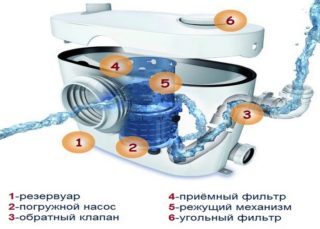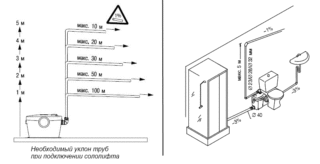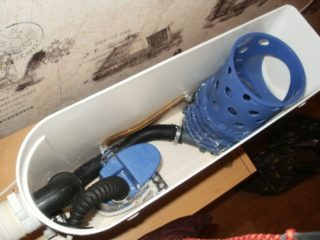Often, in a private house, the location of the sewer riser does not allow transporting sewage by gravity. Or it is not always possible to implement an individual design plan in an already purchased cottage: to move the location of plumbing points, change the places of household appliances and furniture, completely move the bathroom to another part of the house. To bring bold ideas to life, forced sewage in the apartment and in your own mansion will come in handy. Such a device is called a sololift.
Definition and purpose

Sololift is a small device in the form of a reservoir with a built-in powerful pump for pumping wastewater. In some models, a special grinder is provided for transporting fecal matter through pipes.
Use forced sewage in such situations:
- location of the bathroom according to the new project below the collector level or in the basement;
- installation of household appliances working with water in new places;
- transfer of a bathroom or change of points of location of a sink, toilet bowl, bath;
- laundry equipment in the apartment / house.
Forced sewage in private houses is used for those sections of the collector that are located below the level of the underground pipe.
Varieties of forced sewage and operating principles
The sololift functions according to one principle - when sewage enters its reservoir, a powerful pump is turned on, which transports the sewage up to the pipe, through which they can already move by gravity. There are several models:
- Hot waste water pump with grinder. The maximum temperature limit of the liquid is 95 degrees. The universal model copes equally well with both fecal matter and water from the sink, bath, and household appliances.
- Pump without grinder for pumping wastewater with a maximum temperature of 95 degrees. Most often it is installed to transport water from washing machines / dishwashers and shower stalls / bathtubs.
- Model for cold drains with cutting elements. Suitable for installation behind a toilet only.
- Cold waste water pump without grinder. The maximum temperature indicator of the pumped-over water is 45 degrees.
The most expensive models are sololifts equipped with cutting elements.
When buying a device, you need to carefully read the instructions. Some manufacturers recommend forced drainage for specific plumbing fixtures and prohibit use in other cases.
Nuances when installing a sololift

- Sololift is installed on a specially prepared site. In this case, access to the device must be free in case of repair work and maintenance.
- For a toilet, a sololift is needed only with a chopper.
- An electrical outlet must be located near the forced sewer.
- When installing a sololift, it is worth making sure that according to the scheme, the pipe inlet to the pump, coming from the plumbing equipment, is located at a slope towards the device.
When installing a forced sewage system, all joints should be sealed with gaskets that come with the kit. It will be useful to use a sealant.
Operating and maintenance principles

In order for the forced sewage system to work smoothly, first of all, you need to take care of a stable electrical voltage in the house. Otherwise, the service life of the sololift will be extended by such preventive actions:
- Regular cleaning of the receiving tank from sludge accumulated on the walls. Plastic is well washed with plain running water.
- Prevention of aggressive substances entering the reservoir, which can lead to corrosion of the rubber elements of the pump.
- Draining water and drying the sololift in case of seasonal absence from the house.
If for the winter you do not drain the water from the pump and leave everything until spring, then in a cold house, equipment with liquid will freeze. This will lead to damage / rupture.
Advantages and disadvantages of forced sewage
Positive aspects of sololift:
- Compact dimensions. The device is not visible behind the toilet or under the bathroom.
- High performance. Conveys wastewater 100 m horizontally and up to 7 m vertically.
- Possibility of transporting wastewater through pipes of small cross-section.
- Easy to install and maintain.
The disadvantages of forced sewerage include its volatility. But here the problem is solved by the purchase of a generator or the device of an additional tank for the accumulation of wastewater with a volume of 2-3 days until the electrical faults are eliminated.








